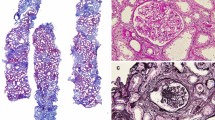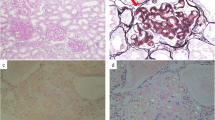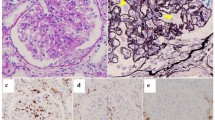Abstract
Fibrillary glomerulonephritis (FGN) is a rare glomerular disease. FGN is characterized by the deposition of randomly arranged, nonbranching microfibrils in the mesangium and glomerular basement membrane. The discovery of DNAJ homolog subfamily B member 9 (DNAJB9) in 2017 was a breakthrough, and DNAJB9 has been proven to be extremely useful for the definitive diagnosis of FGN. While FGN often occurs in middle-aged individuals, this case was diagnosed at a relatively young age of 17. We performed renal biopsy, and light microscopic study revealed mesangial proliferation with expansion and subepithelial deposits. Electron microscopic study showed glomerular deposition of randomly oriented nonbranching fibrils with a mean of 20 nm. However, direct first scarlet stain for amyloidosis was weakly positive. Therefore, we confirmed the diagnosis of FGN and eliminated the presence of amyloidosis with mass spectrometry. This is the first case in Japan in which the complication of amyloidosis was ruled out with mass spectrometry and FGN was diagnosed using immunostaining and mass spectrometry of DNAJB9. We began treatment with cyclosporine A. One and a half years after the start of the treatment, kidney function continues to be normal.


Similar content being viewed by others
References
Rosenmann E, Eliakim M. Nephrotic syndrome associated with amyloid-like glomerular deposits. Nephron. 1977;18:301–8.
Ivanyi B, Degrell P. Fibrillary glomerulonephritis and immunotactoid glomerulopathy. Nephrol Dial Transplant. 2004;19:2166–70.
Rosenstock JL, Markowitz GS, Valeri AM, Sacchi G, Appel GB, D’Agati VD. Fibrillary and immunotactoid glomerulonephritis: distinct entities with different clinical and pathologic features. Kidney Int. 2003;63:1450–61.
Nasr SH, Vrana JA, Dasari S, et al. DNAJB9 is a specific immunohistochemical marker for fibrillary glomerulonephritis. Kidney Int Rep. 2017;3:56–64.
Nasr SH, Valeri AM, Cornell LD, et al. Fibrillary glomerulonephritis: a report of 66 cases from a single institution. Clin J Am Soc Nephrol. 2011;6:775–84.
Andeen NK, Troxell ML, Avasare RS, et al. Fibrillary glomerulonephritis. Clinicopathologic features and atypical cases from a multi-institutional cohort. Clin J Am Soc Nephrol. 2019;14:1741–50.
Rosenstock JL, Markowitz GS. Fibrillary glomerulonephritis: an update. Kidney Int Rep. 2019;4:917–22.
Asakawa T, Asou M, Hara S, Ehara T, Araki M. Fibrillary glomerulopathy with a high level of myeloperoxidase-ANCA: a case report. Case Rep Nephrol. 2020;2020:6343521.
Uchida T, Komatsu S, Sakai T, Kojima A. Complete remission of DnaJ homolog subfamily B member 9-positive fibrillary glomerulonephritis following steroid monotherapy in an elderly Japanese woman. CEN Case Rep. 2020;10:442–7.
Alexander MP, Dasari S, Vrana JA, et al. Congophilic fibrillary glomerulonephritis: a case series. Am J Kidney Dis. 2018;72:325–36.
Said SM, Rocha AB, Royal V, et al. Immunoglobulin-negative DNAJB9-associated fibrillary glomerulonephritis: a report of 9 cases. Am J Kidney Dis. 2021;77:454–8.
Menon S, Zeng X, Valentini R. Fibrillary glomerulonephritis and renal failure in a child with systemic lupus erythematosus. Pediatr Nephrol. 2009;24:1577–81.
Bahrami D, Henegar JR, Baliga R. Fibrillary glomerulopathy in a 10-year-old female. Pediatr Nephrol. 2001;16:916–8.
Bircan Z, Toprak D, Kilicaslan I, et al. Factor H deficiency and fibrillary glomerulopathy. Nephrol Dial Transplant. 2004;19:727–30.
Chung WY, Lee SY, Joo JE. Fibrillary glomerulonephritis in a 9-year-old girl. Nephron. 1995;69:79–82.
Mazzucco G, Casanova S, Donini U, et al. Glomerulonephritis with organized deposits: a new clinicopathological entity? Light-, electron-microscopic and immunofluorescence study of 12 cases. Am J Nephrol. 1990;10:21–30.
Shim YH, Lee SJ, Sung SH. A case of fibrillary glomerulonephritis with unusual IgM deposits and hypocomplementemia. Pediatr Nephrol. 2008;23:1163–6.
Takemura T, Yoshioka K, Akano N, et al. Immunotactoid glomerulopathy in a child with Down syndrome. Pediatr Nephrol. 1993;7:86–8.
Acknowledgements
We would like to thank Mr. Norihiko Suzuki, Ms. Naoko Asano, Ms. Yuriko Sawa, and Ms. Ryoko Sakamoto (Nagoya University) for excellent technical assistance with light microscopy, immunofluorescence, and electron microscopy. Also, we thank Ms. Naomi Kuwahara and Ms. Arimi Ishikawa (Nippon Medical School) for DNAJB9 immunohistochemistry and mass spectrometry.
Author information
Authors and Affiliations
Corresponding author
Ethics declarations
Conflict of interest
All the authors have declared no competing interests.
Ethics approval
This paper does not contain any studies with human participants or animals performed by any of the authors.
Informed consent
Informed consent was obtained from the patient in the case report.
Additional information
Publisher's Note
Springer Nature remains neutral with regard to jurisdictional claims in published maps and institutional affiliations.
About this article
Cite this article
Hattori, K., Shimizu, R., Tanaka, S. et al. A case of juvenile-onset fibrillary glomerulonephritis diagnosed by mass spectrometry and immunohistochemistry of DNAJB9. CEN Case Rep 11, 412–416 (2022). https://doi.org/10.1007/s13730-022-00693-3
Received:
Accepted:
Published:
Issue Date:
DOI: https://doi.org/10.1007/s13730-022-00693-3




